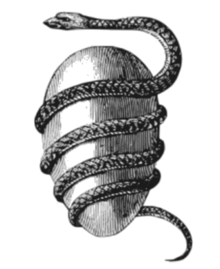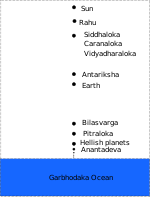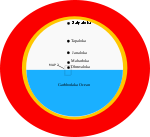- World egg
-
A world egg or cosmic egg is a mythological motif found in the creation myths of many cultures and civilizations. Typically, the world egg is a beginning of some sort, and the universe or some primordial being comes into existence by "hatching" from the egg, sometimes lain on the primordial waters of the Earth.[1][2]
Contents
Sanskrit scriptures and Vedanta
The earliest ideas of "Egg-shaped Cosmos" comes from some of the Sanskrit scriptures. The Sanskrit term for it is Brahmanda (Brahm means 'Cosmos' or 'expanding', Anda means 'Egg'). Certain Puranas such as the Brahmanda Purana speak of this in detail.
The Rig Veda (RV 10.121) uses a similar name for the source of the universe: Hiranyagarbha, which literally means "golden fetus" or "golden womb". The Upanishads elaborate that the Hiranyagarbha floated around in emptiness for a while, and then broke into two halves which formed Dyaus (Heaven) and Prithvi (Earth) - concepts that existed in nearly every ancient culture, and were also articulated by the Abrahamic religions. The Rig Veda has a similar coded description of the division of the universe in its early stages.
Chinese mythology
In the myth of Pangu, developed by Taoist monks hundreds of years after Lao Zi, the universe began as an egg. A god named Pangu, born inside the egg, broke it into two halves: the upper half became the sky, while the lower half became the earth. As the god grew taller, the sky and the earth grew thicker and were separated further. Finally Pangu died and his body parts became different parts of the earth.
Egyptian mythology
In the original myth concerning the Ogdoad, the Milky Way arose from the waters as a mound of dirt, which was deified as Hathor. Ra was contained within an egg laid upon this mound by a celestial bird. In the earliest version of this myth, the bird is a goose (it is not explained where the goose originates). However, after the rise of the cult of Thoth, the egg was said to have been a gift from Thoth and laid by an ibis, the bird with which he was associated.
Finnish mythology
In the Kalevala, the Finnish national epic, there is a myth of the world being created from the fragments of an egg laid by a diving duck on the knee of Ilmatar, goddess of the air:
- One egg's lower half transformed
- And became the earth below,
- And its upper half transmuted
- And became the sky above;
- From the yolk the sun was made,
- Light of day to shine upon us;
- From the white the moon was formed,
- Light of night to gleam above us;
- All the colored brighter bits
- Rose to be the stars of heaven
- And the darker crumbs changed into
- Clouds and cloudlets in the sky.
Representations
- In the temple of Daibod, Japan, it is represented as a nest egg floating in an expanse of water.
- On the island of Cyprus, the egg is represented as a gigantic egg-shaped vase.[3]
In modern cosmology
The concept was resurrected by modern science in the 1930s and explored by theoreticians during the following two decades. The idea comes from a perceived need to reconcile Edwin Hubble's observation of an expanding universe (which was also predicted from Einstein's equations of general relativity by Alexander Friedmann) with the notion that the universe must be eternally old. Current cosmological models maintain that 13.7 billion years ago, the entire mass of the universe was compressed into a gravitational singularity, from which it expanded to its current state (following the Big Bang), the so-called cosmic egg.
Georges Lemaitre proposed in 1927 that the cosmos originated from what he called the primeval atom.
In the late 1940s, George Gamow's assistant cosmological researcher Ralph Alpher, proposed the name ylem for the primordial substance that existed between the big crunch of the previous universe and the big bang of our own universe. [4]
Influences on science fiction and popular culture
The cosmic egg concept has caught the imagination of many science fiction and fantasy writers, including the creators of the Marvel Comics character Galactus. Galactus, with the help of the Phoenix Force managed to survive the previous Big Crunch and, preserved in the cosmic egg, emerged as a being of immense power in the present universe. The cosmic egg concept was also used by DC Comics and Marvel comics in their Avengers/JLA crossover, in which it was used to capture their mutual enemy Krona.
In the 1970 science fiction novel Tau Zero by Poul Anderson, a starship forced to travel very close to the speed of light by an engine malfunction survives traversing our universe collapsing via a big crunch into a cosmic egg and re-exploding in a new big bang. The crew of the starship finds a planet similar to Earth in the new universe, upon which they land and establish a colony.
In 1972 science fiction novel The Gods Themselves by Isaac Asimov, baby universes, in their cosmic egg stage, are used as alternative fuel.
In the popular Pokémon series of games, the Alpha Pokémon Arceus is said to have been born from a Cosmic Egg in a churning turmoil of chaos; proceeding to shape the universe with its 1000 arms.
The Australian Rock band Wolfmother released their album Cosmic Egg on October 23, 2009.
See also
Notes
- ^ "Mundane Egg —". Infoplease.com. http://www.infoplease.com/dictionary/brewers/mundane-egg.html. Retrieved 2011-02-01.
- ^ "Brewer, E. Cobham. Dictionary of Phrase & Fable. Mundane Egg (The)". Bartleby.com. http://www.bartleby.com/81/11799.html. Retrieved 2011-02-01.
- ^ Northvegr: The Northern Way
- ^ The Cosmos--Voyage Through the Universe series, New York:1988 Time-Life Books Page 75
References
- Eino Friberg, trans., The Kalevala: Epic of the Finnish People. Otava Publishing Company, Ltd., 4th ed., p. 44. (1998) ISBN 951-1-10137-4
- Elias Lönnrot, Kalevala. (1849)
External links
Categories:- Creation myths
Wikimedia Foundation. 2010.



